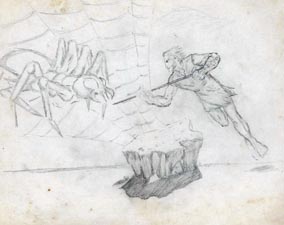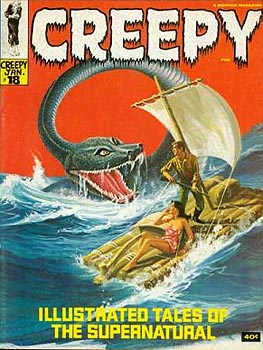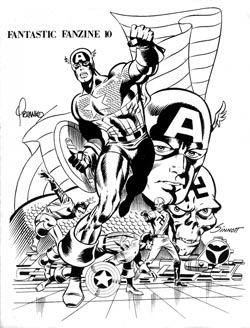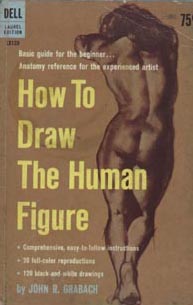A Tribute
Remembering Larry by Steven E. Mitchell

Steve, inspired by the 1957 movie, The
Incredible Shrinking Man,with Grant Williams
(Continued...)
Ralph, Larry, and I shared a number of similar interests, Bobby less so. Larry loved comic books and science fiction and monster movies, then readily available on the three Memphis commercial television stations. Fantastic Features was a special favorite (the anthology film Black Sabbath impressed Larry very much), as well as the occasional science fiction film marathons on Channel 3’s Early Movie (where we first saw The Incredible Shrinking Man). Larry and Ralph both enjoyed Dark Shadows, but I was never able to develop an interest in the series. At that time, both Ralph and Larry shared an interest in similar, fundamentalist religious activities.
Larry’s father, William Franklin Danehower, exerted substantial influence and control over Larry, but was also clearly proud and protective of him. When we first met the father, he seemed to question us fairly closely, and Larry later said that his father had decided he liked us, probably giving Larry his approval to continue to be friends with us. Once, when we were visiting his house, Larry told us he had just gotten a new suit, and his father had insisted on buying Larry a hat, as well. I couldn’t imagine anyone of Larry’s age either wanting or wearing a hat, but his father, no doubt still living, at least in part, in his youth in the 1930s and 1940s, had said that Larry had to have a hat to go with a suit. I don’t recall if Larry modeled the hat for us, but, given his family’s always perilous financial situation, the suit was likely the one he was buried in.
Although Larry was constrained by his family’s allegiance to the Church of God—Larry may have never seen a movie in a theater—he apparently did enjoy considerable freedom when it came to comic books and television. For example, despite his religious upbringing, it was Larry who introduced us to Creepy, Eerie, Gil Kane’s His Name Is Savage, and, later, Web of Horror. Larry’s father read some of these magazines, because Larry told about his father’s amused reaction to the exaggerated anatomy of one of Steve Ditko’s women in a sword-and-sorcery story in Creepy (probably #14, “Where Sorcery Lives”). However, I do recall Larry recounting one instance when his father turned off their television during an episode of the series Journey into the Unknown (possibly “One on a Desert Island,” December 19, 1968) because its subject matter was more explicit than the father thought acceptable. On at least one occasion, Larry was visiting when Rowan and Martin’s Laugh-In was on. He had never seen the program, which was probably forbidden in his home, and he laughed almost non-stop the whole hour.

to me, in large part for the memories
associated with it.
Ralph and I spent two nights at Larry’s—actually, one at his house and one in a tent inside of a tent. One was the night of October 6, 1967, when we watched the Star Trek episode “Mirror, Mirror.” Mostly we listened to it, because the Danehowers didn’t have an external antenna, so we took turns holding one of the rabbit ears in a futile attempt to improve reception. We also watched Fantastic Features, but I have no memory of what movies were shown. That night, we walked downtown, which was only a few blocks from Larry’s house, and which is vividly impressed upon my memory because I had never lived close enough to any town to do that. I bought Creepy #18 at Priestly’s Drug Store. I was initially disappointed in that issue, but it has become invaluable to me, in large part for the memories associated with it. The second time we stayed at Larry’s, we slept in a tent set up inside a large revival tent, to keep an eye on the larger tent. Shortly after that, we stayed in the same tent in Ralph’s back yard, vowing to stay awake the entire night. When Larry fell asleep, we balanced a chess piece on the tip of his nose, no doubt imagining we were extremely funny.
Larry was the real artist of the four of us, with a boundless enthusiasm for his art, and especially for the art of comic books. He took all the art classes offered by the Trumann schools, and continued in his senior year at Marianna. He was as interested in painting as he was in pencil illustration, and in remembrances posted on their forty-year reunion web site, several of his Marianna classmates commented favorably on his paintings. He was constantly studying the work of comic book artists he admired, such as Joe Kubert, Neal Adams, Gil Kane, and, earlier, Jack Kirby. He would emulate their styles until he had incorporated elements of their work into his own drawings. He created his own characters, as did Ralph and I, especially in the superhero and science fiction genres, and, at the last, barbarians and warriors from the subgenre of sword and sorcery.
Larry loved to talk about the things he was enthusiastic about, and he could do so to the exclusion of his surroundings. An incident my mother liked to recall and still laugh about years later: One weekday morning, Larry walked to our trailer and my father gave us all a ride to school. Throughout the ride, Larry talked continuously, and when we arrived in front of the school, he never missed a beat, talking all the time he was getting out of the back seat of the car and walking up to the school building. After this incident, Ralph and I often referred to his as “walkie-talkie.” I also recall one day, while we were waiting in the line to the lunchroom, how Larry reviewed and, to some extent, reenacted some of his favorite episodes of the series The Man and the Challenge, which I had never seen and, at the time, was completely uninterested in.
His nonstop talking could become annoying, also. When the Star Trek episode “A Private Little War” was rerun on August 23, 1968, Larry was at our trailer and watched it with me. But, rather than the episode—which I had seen before—I mostly remember Larry’s stream of comments and questions, a memory now much more valuable to me that of the mediocre and somewhat silly episode. More serious to me at the time was Larry’s visit during a syndicated rerun of Alfred Hitchcock Presents. That day, the final episode of “I Killed the Count,” a three-part story, was shown. I had watched the earlier parts the previous days, so I had to fill Larry in on what had gone before. Then, just as the story is resolved and John Williams makes the final, essential comment that wraps up all three episodes, Larry started talking, probably questioning something about the program. He almost immediately realized what he had done and asked me what Williams had said, which I didn’t know (and wouldn’t know for almost forty years). I recall being very mad and probably showing it, since he seemed very contrite.
At the end of the 1969 school year, Larry’s family moved to Harrison, and then, near the end of the summer, to Haynes, which turned out to be the Danehower family home. Even though he was several counties away from us, Larry visited Trumann a number of times during the following year, usually arriving unexpectedly during the school day or on the weekend (he hitchhiked more than once from Lee County to Trumann). Once during our senior year, there was some sort of athletic meet being held at the Trumann school, and two boys from Marianna came up to me in the lunchroom and relayed a message from the “guy who looked like Tony Curtis” that he would be coming to visit soon. Shortly after we moved from the trailer on Palm Street to a house on Crest Avenue, Larry walked up unannounced, having asked directions of people along Main Street until he miraculously came to the right house.
We also exchanged infrequent letters—Larry was not a consistent or reliable correspondent— and drawings during that year. His family remained desperately poor, which is probably why, after his second divorce, Larry’s father eventually moved back with Larry’s grandparents. Larry’s letters have several references to migratory agricultural labor, such as picking berries or hauling hay, to raise money for school. While in Trumann, he had briefly worked as a bag boy at the Liberty Cash Grocery, but he was fired because he didn’t know one model of car from another and more than once put groceries in the wrong vehicle.

featured Russ Cochran, who
studied illustration in the Navy.
On May 22, Larry graduated Marianna High School. Since he had received a low number—#56—in the selective service lottery that year and was virtually assured of being drafted, he had enlisted in the Navy on May 19 and was to enter the service later in the summer. Larry had worked out a plan for the next few years. He had ordered a copy of Fantastic Fanzine #10 from a catalogue I had sent him, and in that he read a biography of an aspiring artist who, while in the Navy, had submitted samples of his work to several comic book companies and had the promise of a job when his enlistment was up. The artist was Russ Cochran, whose artwork revived the X-Men, the version used in the current series of movies. Larry modeled his immediate future on Cochran’s example. He had applied to the illustration and drafting branch of the Navy and, after his term of service was up, planned to use the G.I. Bill to study art in college, either becoming a comic book artist or an art teacher.
Larry spent the week of June 21, 1970, in Trumann, staying about half the week at my house and half at Ralph’s. I imagine we did a lot of catching up on comic books we had collected and television we had watched, but I have retained very little detail of that week. We did foolishly hike to Steven’s Landing, walking the length of that dusty gravel road for no good reason. Part of the way back, someone gave us a ride, on what seemed to be the hottest, most miserable day of the year. During that week, some of my family’s friends from Harrisburg, the Hickmans, also visited, and their two older daughters, both very blonde and attractive, were very much taken with Larry and were later stunned to learn of his death only days after they met him. Also during that week, Larry called his grandfather from Ralph’s house to ask if Ralph and I might spend the next week at the grandparents farm, but they refused, offering some excuse of a church camp meeting or revival.
Larry had spent the early part of the week at our house, and intended to spend the last part at Ralph’s. However, on Saturday, the 27th, he returned to our house and almost apologetically asked if he could spend the night. To Larry’s obvious disappointment, Ralph was leaving that day on a church-related trip to Louisiana. We assured Larry he was welcome, and we spent much of that day drawing and probably watching television. I have a number of Larry’s unfinished sketches and several collaborations we did that day, including two of my Death’s-head character with Larry’s elaborate shading. On Sunday, June 28, Larry left Trumann to return to Haynes. I drove him to the intersection of Ozark Avenue and Highway 63, where he got out to begin hitchhiking back to Haynes. When he turned to wave as he walked away, for just a moment he had a peculiar, puzzled expression on his face, which I have remembered and wondered about ever since. After a few seconds, he smiled, then turned and walked on to the highway.
The following week, I kept expecting a letter from him—he may have even promised to send one. Instead, five days later, on Friday, July 3, 1970, when we were shopping at Young’s Big Star, my half cousin drove up and told me Larry’s grandfather had called their number—at the time we didn’t have a telephone and my cousin’s family were the only Mitchells listed in the Trumann phonebook—trying to reach me to tell me that Larry was dead. I called back from a pay phone and learned that Larry, his father, and some friends had been swimming in an abandoned gravel pit earlier in the day and Larry had drowned. Larry’s father had vainly tried to save his son and had to be pulled from the pond for fear he would also drown. His grandfather asked if I and Larry’s other friends would serve as pall bearers. Ralph was still away at the church meeting in Louisiana, but Bobby Parnell and James Jernigan, who also knew Larry from school, went with me and my parents to the funeral, on Sunday, July 5, and were also pall bearers. Because Larry had been close to us, his father and grandparents invited my parents to sit with the family during the funeral service.
After the funeral, we went to the grandparents’ house. I regret that I did not go inside, since they apparently had some of Larry’s paintings and other artwork on display, but I was still mad that we hadn’t been allowed to visit Larry, probably thinking it would have made some difference in the way things turned out. Instead, Bobby, James, and I remained outside and talked with Larry’s female cousin, with whom he had shared a date not long before his death. My mother, who did go in the house, said the father had told how Larry had regaled the family with the story of that date, which, as Larry recounted it, had been a string of hilarious misadventures and blunders. Larry’s father asked if I would take Larry’s comic book collection, which I agreed to do, and, except for a few copies I gave to James and Ralph, I still have it, along with Larry’s copy of Grabach’s How to Draw the Human Figure.

which he felt would help him
with fantasy illustrations.
Although I was acquainted with Larry for almost four years, I realize now that I really never knew him. We generally didn’t talk about the personal details of our lives, or, if we did, I didn’t retain much memory of what Larry might have told me. Although I knew his birth date, I don’t know where he was born. His parents were divorced—his birth mother, Mary Alice Romans, did not attend Larry’s funeral—but I don’t know when they divorced or where they were living when the divorce occurred. His father’s second wife was a bloated harpy who probably made life miserable for Larry, his father, and his brother, based on Larry’s evident relief when he told us his father had also divorced her, about the time they moved from Trumann to Harrison. Larry’s older sister, Bonnie; his older brother, Franklin; Larry; and probably his younger brother, Donald Eugene (Gene), all attended school in Forrest City in the early 1960s, just before Larry moved to Trumann. By the time we knew Larry, Franklin lived in Georgia, where Larry’s family visited at least once shortly before Larry died. His mother was also living in Georgia when Larry died, but I don’t know what the family’s connection to that state might be. Bonnie—Barbara Lavon—also moved to Georgia before Larry’s death. She died in 2009.
After forty-two years, the memories of our brief time with Larry have become clouded and unreal. Too many of our conversations and activities were too mundane to be retained. What does stand out are the few incidents that transcended the ordinary. I can clearly recall, during Larry’s last visit, sitting with him in my bedroom in the house we had only lived in for about six months, drawing with our paper spread on folding TV trays. We each had a glass of some soft drink perched on the tray, as well. Suddenly, Larry leaned too heavily on his tray and it collapsed, scattering his papers and spilling his drink. He was mortified, since I’m sure we had sometime during his visit made some comment about keeping the new carpet clean. We blotted up the spill and assured him it was all right, but he was still remorseful. After over four decades, the unfinished drawing he was working on, splattered with soft drink stains, evokes all the happy memories of that last visit.
